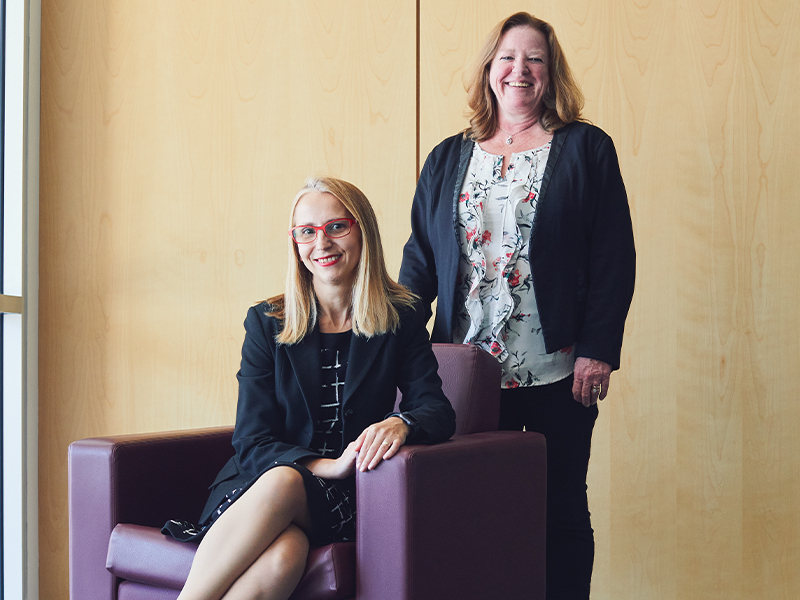
In March 2020, Bill Gosling Outsourcing’s benefits plan was facing unsustainable costs, as well as a deficit due to incoming premium increases.
The coronavirus pandemic, which was declared at the same time, presented an opportunity for the organization to make significant changes. “During the pandemic, people were housebound, so they weren’t going to the dentist and incurring as many drug claims,” says Janice Neshevich (right in photo), director of human resources at Bill Gosling.
“We saw this as an opportunity to make bold changes . . . and to revisit additional benefits like our [employee assistance program] because there were a lot of issues surrounding mental health and well-being.”
Read: Employee experience, well-being top priority during pandemic: survey
Kim Siddall, vice-president of enterprise consulting for the West at People Corporation, agrees. “Employers need to make sure their mission, vision and values are still aligned with the design of their benefits plan and what it’s intended to do.”
Deep dive
In addition to facing high benefits plan premiums and low engagement, Bill Gosling found its plan wasn’t helping to attract or retain employees, especially in a high turnover industry. With the help of its consultant, the company worked quickly to revamp the plan, with the changes fully implemented by Aug. 1, 2020.
The project started with a survey of the organization’s global leadership, which helped the HR team understand the lifecycle of employees. It also used an online objective-setting tool to identify any alignments and gaps in the plan. Within a week of starting the project, the organization was able to use these clear objectives to quickly move the process forward.
“When a company reaches such a position, it’s time to take a deep dive into everything benefits related, from plan design to systems capability, and analyzing what’s working, what can be improved and how to align everything so we make the right changes to overcome the deficit and meet employee needs,” says Clara Iacob (left in photo), benefits specialist at Bill Gosling.
By the numbers
• 62% of Canadian plan sponsors said their health benefits plan didn’t change in 2022.
• 30% of plan sponsors that did make changes added a benefit(s) or improved coverage levels.
• 7% of plan sponsors removed a benefit(s) or reduced coverage levels.
Source: 2022 Benefits Canada Healthcare Survey
The organization’s new plan is available to all full-time employees, regardless of their benefits eligibility, which previously included different waiting periods, she adds. This included bringing back mental-health care through the EAP, which was cut back during the previous benefits renewal; introducing a virtual doctor program; and providing employees with access to preferred rates on personal insurance products.
Read: Half of Canadians would leave job if flexibility isn’t extended post-pandemic: survey
In order to align with employees’ growing desire for flexibility and easy access, Bill Gosling also partnered with a virtual pharmacy to provide online access to drug coverage at a 15 per cent lower cost than retail. It also made changes to its plan to focus on medically essential coverages, adjusted life insurance coverage to reflect the demographics of the company and maintained its highly valued vision and dental coverages.
Between March and October 2020, Bill Gosling eliminated its benefits plan deficit and the cost of the plan decreased by nine per cent upon renewal in August 2020. It also began to run a financial surplus that was used to further enhance benefits on Aug. 1, 2022. For example, the company improved its dental plan, adding major dental to certain benefits groups, and increased coverage for eye exams. It also used the surplus to cover most of the premium rate increases for the employer and employees.
“We wanted to make sure our employees were impacted in a positive way,” says Neshevich. “The deficit was substantial and it was over the course of a few years of not making the right decisions, not increasing premiums when we should have and we learned a very valuable lesson.”
With many employees experiencing high levels of stress and mental-health issues during the pandemic, Bill Gosling is continuing to build on and promote resources like the EAP, she notes. “We’ve actually seen some increases in our utilization reports. [Our benefits team] is very good at joining team huddles, promoting what we have in place and encouraging people to utilize those services. It’s at no cost to the employee and we’ve had a lot of positive feedback.”
Read: North American employees experiencing highest stress levels amid pandemic: survey
Iacob also stresses the importance of educating employees about the mental-health resources that are included in a company’s benefits plan. “We make sure to continue educating employees on what these programs have to offer and to how to use them. We encourage them to reach out to [our team] if they have any questions or if they need any guidance. Building this relationship and continuously educating them on these tools is very beneficial for employees and for the company.”
For any employers deciding whether to make changes to their benefits plans, Siddall suggests they consider a few key aspects, including the areas in which they want to provide more coverage. Another consideration is whether they want to remove obstacles to access by increasing the number of eligible providers under their plan, she adds.
Employers could also look at adding another layer of programming that provides preferential pricing or digital solutions to diagnostics, similar to what Bill Gosling did by adding a virtual doctor program, says Siddall. “It really depends on your own circumstances as a plan sponsor and what the goals are for your plan.”
Sadie Janes is an associate editor at Benefits Canada.
